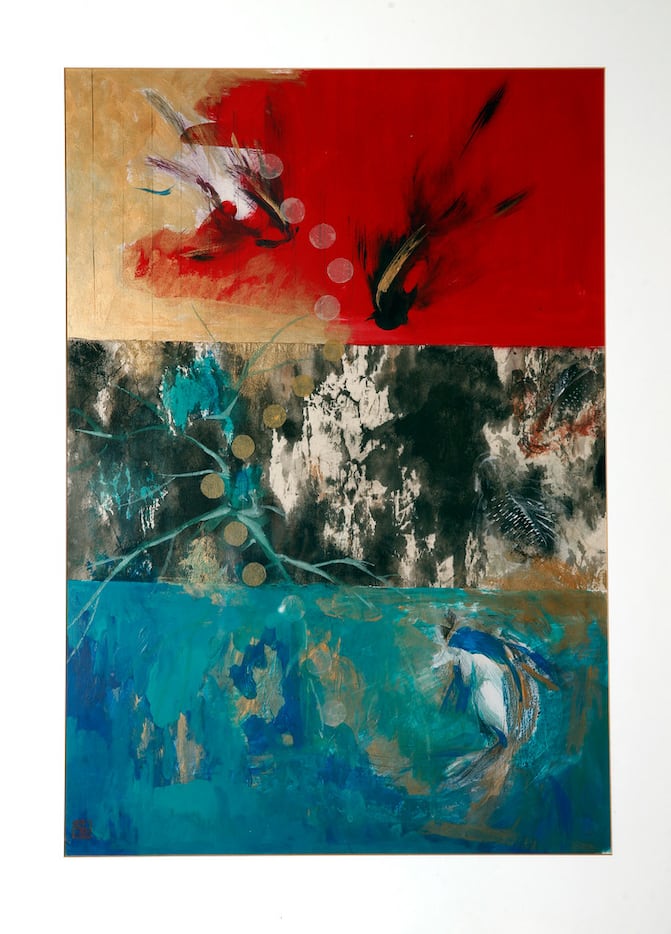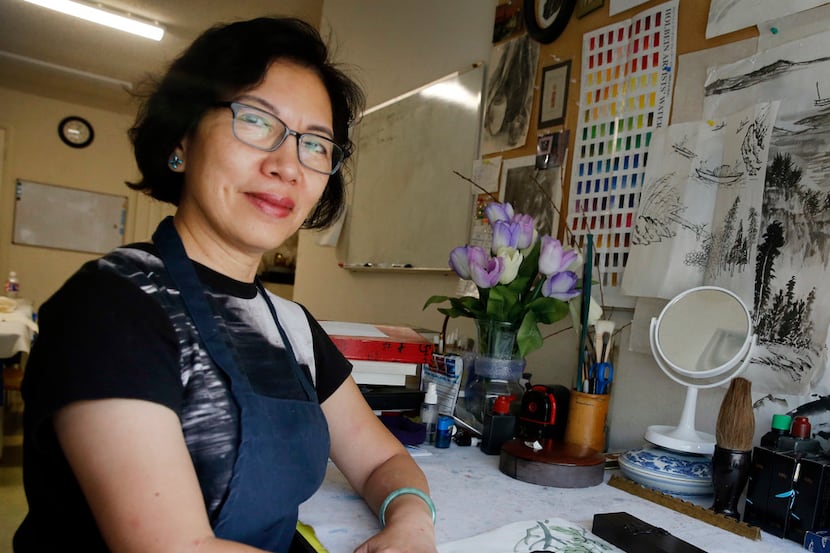In traditional Chinese brush paintings, it's not unusual to find a scene of galloping horses, with delicate calligraphy spilling down the margins. But it is somewhat unusual to encounter a Texas cowboy swinging a lariat over his head, as depicted in a piece by Jenney Chang.
In the Plano artist's works, East and West come together.
A pillar of the North Texas Chinese and Taiwanese American communities, Chang has helped hundreds of local students develop their artistic skills. She combines her personal experience as an immigrant with her artistic philosophies in her own work, which is on display until Aug. 24 as part of the ArtCentre of Plano exhibit "FLOW: The Dedication of Women."
"In American culture, it's all about ambition," says Chang, 60, speaking in Mandarin, the language she is most comfortable with. "But Chinese culture is about being humble, about giving, not snatching. It's about harmony. It's a completely different philosophy. In this show, I'm trying to represent Chinese virtues, Chinese landscapes."
The classic — or stereotypical — immigrant story is that of the young person who dreams of a better life and rises to fame and fortune. Chang's story is a different one, perhaps more common but less told. She wasn't fueled by ambition, but was open to opportunities that guided her to where she is now.
Growing up in Taipei, Taiwan, Chang had a natural gift for drawing and inherited a love of nature from her mother. She ended up enrolling at the National Taiwan Normal University, the only one of nine siblings to attend college. There, she studied fine arts and learned the meticulous techniques of traditional Chinese painting.
'No erasing'
Chinese art instruction "was focused on perfecting line strokes, [how to] control the brush, where to use colors richly, and where to use colors sparingly," says Chang. "In Chinese painting, there is no erasing."
But Chang was also exposed to Western thought in a required philosophy class, where, she says, she was taught "how to have a dialogue with yourself, and how to let your ideas develop."
Chang enjoyed being pushed to think more deeply about art. After college, she taught art at a local middle school, where she met her husband, a Chinese teacher. In 1986, the pair immigrated to Texas so that her husband, Dennis, could obtain a master’s degree.
"When I came to America, I thought, 'What can I do?' There was no Chinese painting," says Chang. "I thought about how I never understood abstract art in college. I wanted to learn about the artists' motivation, and to learn how to appreciate abstract art."
So she also enrolled in a master's program at what is now Texas A&M University-Commerce. Chang studied the surrealism of Marcel Duchamp and the thoughtful simplicity of Robert Motherwell.
Although she was learning new techniques and styles, Chang struggled with being in a different environment, and having to speak a new language.

She poured her emotions into assignments that integrated elements of Western and Chinese art. In a piece she calls Transitions, Chang depicts koi fish weaving through three colorful panels made of tape, acrylic paints and Chinese ink on rice paper.
"It symbolizes my journey from Asia to the West," says Chang. "I was wandering, I was learning. I painted myself in this."
The panels are connected by golden bubbles and lotus leaf veins. Chang's choice of visual elements — lotus and koi — was deliberate. "My images are all from Chinese culture," says Chang, "because those are all rooted in my mind."
After completing their degrees, Chang and her husband embarked on their own careers. Dennis opened a computer retail store in Richardson. Chang taught parents how to paint at local Chinese schools while their children learned Mandarin.
Finding connections
In 1998, Chang started offering lessons from her home. She infuses her instruction with impromptu lectures about the cultural origins underlying Chinese painting. "Chinese painting is rooted in a philosophy that heaven, nature and people are all connected," says Chang.
The link to Chinese philosophy is important to many of Chang's students, including Katherine Wang, 19, of Plano. Like many children of Chinese immigrants, Wang is able to speak Sichuanese, her parents' mother tongue, but lacks literacy in Chinese characters.
Wang says learning Chinese painting "connects me more to my Chinese culture... [it's] like learning the culture and language without having to read or write."
Even though Chang starts her Chinese painting students with rigorous, technique-building exercises, she also encourages students to develop their own styles, just as she did during her master’s degree program.

Alice Kuan, 56, of Plano, has been studying with Chang, on and off, for about a decade. Initially, Kuan struggled with the seemingly rigid traditions of Chinese paintings. "I wanted to create something that is myself," says Kuan, "but I was trying to paint the things in Chinese paintings like flowers, lotus, things like that."
Chang recognized that the typical subjects of Chinese painting didn't interest Kuan, so she encouraged Kuan to paint the subjects she truly cared about, like her daughter as a ballerina.
Kuan appreciates Chang's willingness to adapt lessons to her students' needs. "You can see her skill set and her depth of understanding," says Kuan. "I'm very fortunate to study with her."
Her own art
Over the years, Chang focused on teaching in order to help support the family, which left little time to explore her own art. She juggled working, raising her daughters and caring for Dennis, who suffered from chronic heart failure. He died in 2015. It was a difficult time for Chang, and she sought solace in her art.
"Everything I paint now is very peaceful," Chang says. She devoted herself to painting snow falling on plum blossoms, cardinals perched on gnarled pine boughs and twining wisteria vines.
Chang also took some time to travel with friends. Last year, during a 21-day road trip to 11 national parks, she was inspired to start a new project. "I know that many people here feel a deep connection to the U.S. national parks," says Chang.
The connection, she thinks, is not so different from the philosophy that roots traditional Chinese painting in natural scenery.
So Chang set herself the goal of depicting 10 national parks in the style of traditional Chinese painting. Chang hopes to show the iconic landmarks in a new light by employing Chinese painting techniques, like composition and perspective.
In contrast to the fixed perspective often featured in Western art, Chinese paintings are typically composites of multiple views. Chang believes that this technique allows for a more accurate snapshot of a person’s memories and feelings.
"Chinese painting is like re-experiencing your travels: You look above, below and behind," says Chang. "When you travel, you don’t just see one angle. You see an entire environment."
So far, Chang has painted three national parks. Her works of the Grand Canyon, Bryce Canyon and Arches parks are currently on display with other examples of her work at the ArtCentre of Plano.
'Luminous and dreamlike'
Amy Darrow, 59, president of the ArtCentre's board of directors, was struck by the "luminous and dreamlike" quality of Chang's paintings. Chang is "visiting our national parks and interpreting them through this historic, traditional style of painting," says Darrow. "I'm humbled by how art can overcome any communication barriers."

Chang's daughters, Nicole and Debbie, say her ability to combine viewpoints and styles reflects something deeper: their own identities. "It's kind of like a little bit of me," says Nicole, 21, who lives in Dallas. "I'm Asian, I'm Taiwanese — that's always going to be a part of me — but I also grew up here, so that merge was always an inspiration."
Debbie, 23, who lives in Austin, says her mother’s art is a symbol of the physical, emotional and philosophical journey that Chang has taken. "It takes a conscious choice to develop your own style rather than just following in the footsteps of someone else," says Debbie. "If you develop the eye of an artist, you can't see the world the same way as a lot of other people, and it's truly a blessing."
Chang has come into her own as an artist and now shares her vision with those around her. But she doesn’t see any of that as extraordinary.
"Whatever environment I'm in, I try my best," she says. "My hope is to help influence the next generation with art. They don't necessarily have to become artists, but I just want to impact their lives — if only a little — with my art. That’s what I can do."
The exhibit "FLOW: The Dedication of Women" is on display through Aug. 24 at the ArtCentre of Plano, 902 East 16th St., Plano, 75074.

